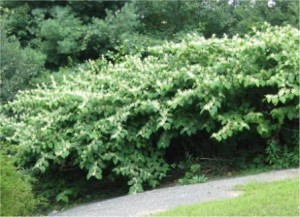Japanese knotweed is an herbaceous perennial which forms dense clumps 1-3 meters (3-10 feet) high. Its broad leaves are somewhat triangular and pointed at the tip. Clusters of tiny greenish-white flowers are borne in leaf axils during August and September. The fruit is a small, brown triangular achene. Knotweed reproduces via seed and by vegetative growth through stout, aggressive rhizomes. It spreads rapidly to form dense thickets that can alter natural ecosystems or interfere with landscaping. Japanese knotweed can tolerate a variety of adverse conditions including full shade, high temperatures, high salinity, and drought. It is found near water sources, in low-lying areas, waste places, and utility rights of way. It poses a significant threat to riparian areas, where it can survive severe floods.
 Management Options:
Management Options:
A. Grubbing:
This method is appropriate for very small populations or in environmentally sensitive areas where herbicides cannot be used. Using a digging tool, remove the entire plant including all roots and runners. Care must be taken not to spread rhizome fragments. Juvenile plants can be hand-pulled depending on soil conditions and root development. Any portions of the root system not removed will potentially re-sprout. All plant parts, including mature fruit, should be bagged and disposed of in the trash to prevent reestablishment.
B. Cutting:
Repeated cutting may be effective in eliminating Japanese knotweed, but this strategy must be carried out for several years to obtain success. Cut the knotweed close to the ground at least 3 times a year. Cutting stems over time results in a significant reduction of rhizomatous reserves. Manual control is labor intensive, but where populations are small and isolated or in environmentally sensitive areas, it may be a good option.
Both mechanical and herbicidal control methods require continued treatment to prevent reestablishment of knotweed. Reintroducing native plants as competitors may be an alternative to continued treatment. However, more research needs to be done on which native species might be effective competitors and how they should be reintroduced.
C. Herbicides:
Triclopyr will kill the top growth within a few days, but Japanese knotweed may re-sprout following treatment. Residual effects on emergence and growth the following year are variable.
Glyphosate applied in spring or early summer may stunt or yellow growth, but knotweed will generally recover and continue growing. Glyphosate treatments in late summer or early fall are much more effective in preventing regrowth of Japanese knotweed the following year.
Strategy:
Late June – Cut or mow down stalks.
Allow knotweed to regrow.
After August 1, spray knotweed with ROUNDUP [glyphosate (41%)] @ 2.5 fl. oz./gal.
Established stands of Japanese knotweed are difficult to eradicate even with repeated glyphosate treatments. Adequate control is usually not possible unless the entire stand of knotweed is treated (otherwise, it will re-invade via creeping rootstocks from untreated areas). However, glyphosate treatments will greatly weaken the plant and prevent it from dominating a site.
References
Seiger, L. 1992. Element Stewardship Abstract for Polygonum Cuspidatum, (Japanese knotweed, Mexican bamboo). The Nature Conservancy.
Japanese Knotweed (Polygonum cuspidatum ) from Tennessee Exotic Plant Management Manual, April 1997.
More resources:
Comprehensive Knotweed Management Resources, Recommended by Tom Zetterstrom for 2020 CIPWG Symposium
1. Managing Japanese Knotweed and Giant Knotweed on Roadsides, PSU
https://plantscience.psu.edu/research/projects/vegetative-management/publications/roadsidevegetative-mangement-factsheets/5managing-knotweed-on-roadsides
2. Preventing the Spread of Japanese Knotweed, Best Management Practices, Doug Cygan, New Hampshire Dept. of Agriculture
https://www.agriculture.nh.gov/publications-forms/documents/japanese-knotweed-bmps.pdf
3. Weed Control Methods Handbook, The Nature Conservancy, https://www.invasive.org/gist/products/handbook/methods-handbook.pdf